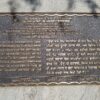This memorial was dedicated on ANZAC Day 2011 in recognition of the Sikh soldiers that were part of the colonial and ANZAC forces. Sikhs made up 22% of the British Indian Army and have been an intergral part in Australia’s conflicts. Roughly 83,000 Sikh soldiers sacrificed their lives alongside the allied forces during World Wars I and II. It was only until ANZAC Day 2015 that the direct descendants of Indian ser The memorial reads:
Guru Nanak Society of Australia Inc.
25, Loudon Road, Port Augusta, 5700, South AustraliaTruth is the highest virtue but higher still is truthful living
“Plaque for the Sikh Soldiers in the Pathway of Honour”
Unveiled by Hon. Mike Rann The Premier of South Australia
On 25th of April 2011“In Memory of all Sikh Soldiers who gave their lives or were wounded in World Wars 1 & 2 and all other wars for the British Raj from 1849 to 1947 including the Epic Battle of Saragarhi on 12th September, 1897. The saga of their valour, undaunted spirit and sacrifices is written in golden letters in the annals of military history of the world.
Kirat Karo- Honest Labour
Naam Japo – Meditate on the Creator
Wand Chhakko – Share your earnings
Bhana Manno – Accept the will of God
Saragarhi
As the memorial mentions, one of the most severe conflicts for Sikh soliders was the Battle of Saragarhi in 1897. This conflict saw 21 Sikh soldiers of the 36th Sikhs British Indian Army facing a ratio of 1:500 against approximately 10,000 to 14,000 Afridi and Orakzai tribes of Pastun. Saragarhi was a communication relay post along the North Western Frontier Province (modern day Pakistan) that served between Fort Lockhart and Fort Gulistan. As this position was vital in maintaining both forts and the defence of the region, it was also an important target for the local Pastun Tribes.
As the Pastun forces cut off the supply line to Saragarhi, the 21 soldiers defending their position were unable to receive needed ammo and reinforcement while holding off the enemy advance. Under the command of Havildar Ishar Singh, the troops took fire upon the enemy as they drew nearer. Fighting off seven charges, the 21 troops had fallen to 10 before falling back to the small block house and signal tower that formed the communication relay. Upon breach, only five Sikhs remained. The 36th Sikhs defended Saragarhi to the last man with four men fighting within the inner building and Sepoy Gurmukh Singh holding and relaying information from the signal tower. Upon transmitting he was the only man left, Sepoy Gurmukh Singh requested permission to leave his post to join the fight.
World War I
In WWI, at least 19 Sikhs are recognized to have enlisted within the Australian and New Zealand forces. While many served within the allied forces, they are especially recognized for their contributions to the Gallipoli Campaign. The 29th Indian Infantry Brigade had an entire regiment known as the 14th Sikhs who were an active force during this campaign. During a day’s fighting on the 4 June 1915, this regiment was almost entirely wiped out whilst facing the Turkish army at Gully Ravine. Its casualties during this conflict have been estimated to total 82% of the regiment that were engaged in the battle.





Comments